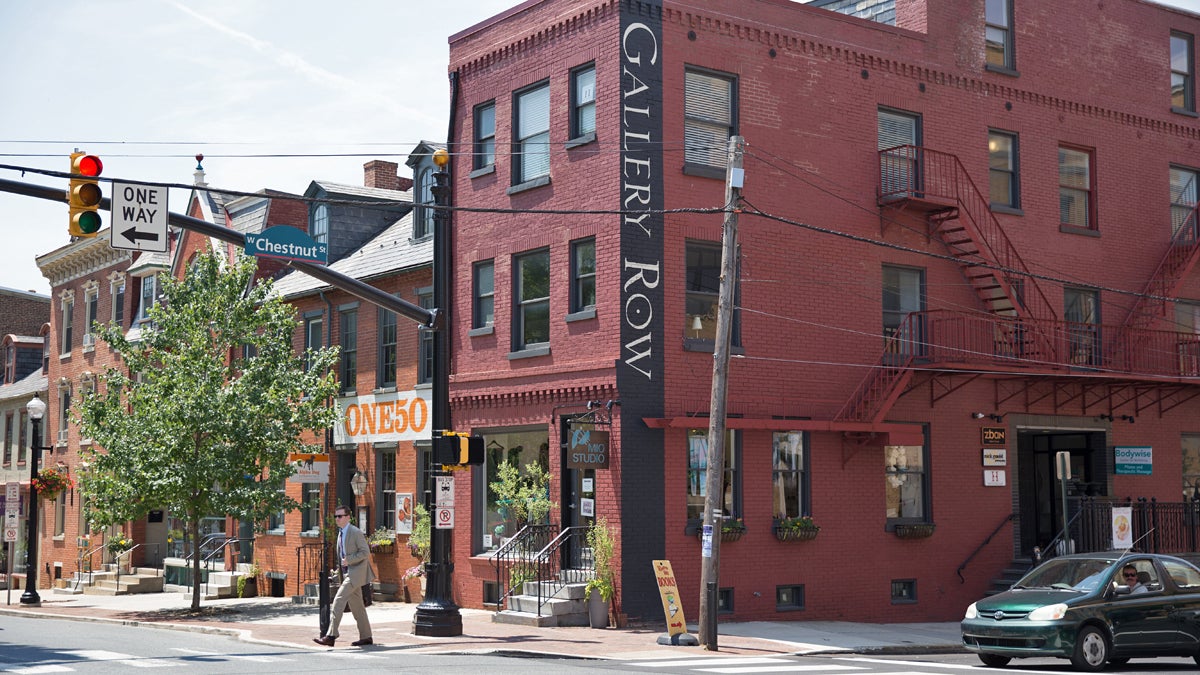Lancaster prospers, but not for all residents

Small shops and studios make up Lancaster's Gallery Row. (Lindsay Lazarski/WHYY)
Downtown revitalization has brought increased inequality and housing insecurity.
It’s been a good couple of years for Lancaster. The city was featured in The New York Times this summer, ranked as the ‘sexiest small city in America’and deemed an e-city by our Internet overlords at Google. There have been big development projects, like the Clipper Magazine Stadium and the Convention Center, and efforts to market Lancaster as a tourist destination.
But not everyone in the city has felt these revitalization efforts equally, a new study from Franklin and Marshall College, in Lancaster, says. In fact, recent economic development may have actually increased the inequality in the city.
The study says that Lancaster has prioritized “increased amenities to be enjoyed by visitors, students, artists and persons with high educational attainment and income.” It concludes that “such a strategy will be accompanied by increased inequality and increased economic stress for most residents.”
The report describes how Lancaster’s success has reached wealthy, white families, and drawn more of that group into the city. But black and Latino families are having a harder time finding mid-level jobs, and in some cases, jobs at all. Poverty and unemployment are on the rise, and home ownership is on the decline.
The stark differences between the haves and the have-nots in Lancaster surprised even the researchers.
“We didn’t go into this study expecting numbers like this” says Berwood Yost, the director of the Floyd Institute for Public Policy, who put out the study. “I was surprised by the high rate of poverty and the increase in housing insecurity.”
Lancaster has an overall poverty rate of about 30 percent. That’s better than Harrisburg, York and Reading. But poverty is more concentrated in black communities where 34 percent of households are at poverty level and Latino communities (44 percent), more so than white households (17 percent).
Revitalization or gentrification?
Through the Lancaster City Alliance, an economic development group for the city, there has been $1.5 billion invested in reviving downtown since 2007. And the study gave credit to that, saying that “areas of the city which have received explicit attention and investments from city officials or civic groups or private stakeholders have benefitted significantly from these investments.”
Yost said he hoped to find that improvements in one part of the city might improve the whole city, “a rising tide lifts all boats” way of looking at the improvements. Instead, the study found that some of those rising tides may have come closer to drowning smaller, less-sturdy boats.
But the Lancaster City Alliance says that was an unrealistic expectation to begin with.
“I can’t tell you how improvements in one part of the city are going to make another part of the city better or worse,” says Bob Shoemaker, president of the Lancaster City Alliance. “But where we’ve applied resources, we’ve seen improvement.”
For example, Lancaster has opened a convention center. Shoemaker says that provides jobs, and brings tourism to the area. But it’s difficult to translate the impact of those jobs into the communities where the workers live.
In some cases, neighborhoods where development has happened became too expensive to live in. Generally, affordable housing is measured as less than 30 percent of your income spent on housing. In Lancaster, 47 percent of residents spend more than that. And it’s worse if you rent: 61 percent of renters devote more than 30 percent of their income to housing.
Opposing viewpoints
Suffice to say, not everyone was pleased with this study. The mayor wrote an op-ed for Lancaster Online that said he had already assembled a task force to combat poverty. He hoped the task force, unlike the creators of the study, would be able to “come down from our ivory towers, get off of our high horses and leave the safety of the bunkers we’ve built around our bigotries.”
Yost says they weren’t trying to point fingers, but rather point out a problem before it’s too late. As many cities in Pennsylvania begin revitalization efforts, they have a chance to confront and possibly overcome gentrification issues that have plagued other cities.
“It’s good for us to know how we are doing as a community,” says Shoemaker, of the Lancaster City Alliance. “We know that poverty is a huge issue facing the community, and we want to create development that’s aware of that fact. We want to make it better, not worse.”
He feels that the Lancaster City Alliance has already been making efforts in that direction. The next phase of development is focusing on seven different neighborhoods in Lancaster, and they’ve held over 100 community meetings to identify what residents want.
WHYY is your source for fact-based, in-depth journalism and information. As a nonprofit organization, we rely on financial support from readers like you. Please give today.


